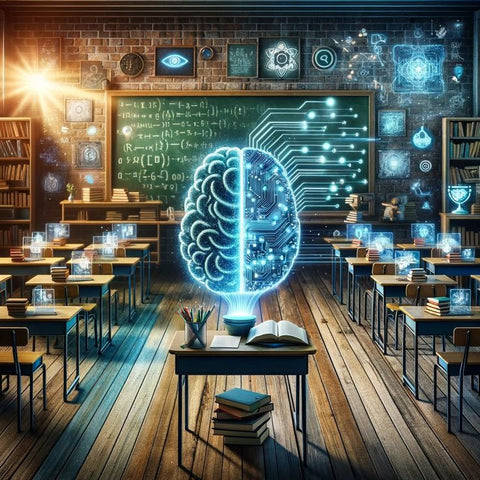#Gamificationineducation
Explore tagged Tumblr posts
Text
Top Education Trends for Kids in 2025
The world of education is constantly evolving, and 2025 is no exception. As technology advances and teaching methodologies adapt, new trends are shaping the way children learn and develop essential skills. Here’s a look at some of the most popular education trends for kids in 2025.

1. Personalized Learning Through AI
Artificial Intelligence (AI) is revolutionizing education by offering personalized learning experiences. AI-powered platforms analyze a child’s learning style, strengths, and areas for improvement, creating customized lesson plans. This approach ensures that each child progresses at their own pace, maximizing learning outcomes.

2. Gamification of Education
Gamification continues to gain traction as a fun and effective way to engage children in learning. By incorporating game-like elements such as rewards, challenges, and leaderboards, students are motivated to actively participate and retain information. Popular subjects using gamification include math, science, and language arts.
3. Focus on Emotional Intelligence (EQ)
In 2025, schools are emphasizing the importance of emotional intelligence alongside traditional academics. Programs designed to teach empathy, self-regulation, and social skills are becoming integral parts of the curriculum, helping children develop well-rounded personalities.

4. STEM and STEAM Education
Science, Technology, Engineering, Arts, and Mathematics (STEAM) education remains a cornerstone of modern learning. With a focus on hands-on projects and interdisciplinary studies, STEAM encourages critical thinking, problem-solving, and creativity, preparing kids for future careers.
5. Integration of Virtual and Augmented Reality (VR/AR)
VR and AR technologies are making learning more immersive and engaging. From virtual field trips to interactive 3D models, these tools bring abstract concepts to life, enhancing comprehension and sparking curiosity in young learners.

6. Eco-Education and Sustainability Awareness
As the world faces environmental challenges, teaching kids about sustainability has become a priority. Schools are incorporating eco-education into their curriculum, focusing on topics like recycling, conservation, and climate change to raise environmentally conscious citizens.
7. Hybrid and Flexible Learning Models
The pandemic paved the way for hybrid learning, and its benefits continue to influence education in 2025. Combining in-person and online learning, this model provides flexibility, accessibility, and personalized support, making education more inclusive.

8. Global Collaboration Projects
With advances in technology, students now have opportunities to collaborate with peers across the globe. These projects teach cultural awareness, teamwork, and global problem-solving skills, broadening their perspectives and preparing them for a connected world.
9. Mindfulness and Mental Health Focus
Recognizing the importance of mental health, schools are integrating mindfulness practices into daily routines. Techniques such as meditation, deep breathing, and journaling help children manage stress, improve focus, and enhance overall well-being.
10. Coding and Digital Literacy
In an increasingly digital world, coding and digital literacy are essential skills. Coding clubs, interactive programming lessons, and courses on safe internet practices are equipping kids with the tools they need to navigate and thrive in the digital age.
Final Thoughts
Education in 2025 is all about innovation, inclusivity, and preparing kids for the future. By embracing these trends, parents and educators can ensure that children not only excel academically but also develop the life skills needed to succeed in a dynamic world.
#momatos.in
#EducationTrends2025#KidsLearning#FutureOfEducation#PersonalizedLearning#STEAMEducation#GamificationInEducation#DigitalLiteracy#MindfulnessForKids#VRInEducation#EcoEducation
0 notes
Text
Gamification in Education: Turning Learning into a Game
https://businesswolfmagazine.com/wp-content/uploads/2024/08/3.Gamification-in-Education_-Turning-Learning-into-a-Game.jpg
In the modern educational landscape, traditional teaching methods are continuously evolving. One of the most innovative and engaging strategies gaining popularity is gamification in education. This approach integrates game design elements into learning environments, transforming conventional educational experiences into interactive and enjoyable ones. By leveraging the motivational power of games, educators can enhance student engagement, motivation, and learning outcomes. This article explores the concept of it is benefits, challenges, and practical implementation strategies.
Understanding Gamification in Education
It involves applying game mechanics, such as points, badges, leaderboards, and challenges, to non-game contexts like classrooms and educational platforms. The goal is to make learning more appealing and to encourage active participation. This concept is grounded in the idea that the principles that make games enjoyable can be harnessed to create a more dynamic and effective educational experience.
Key Elements of Gamification
Points and Rewards: Assigning points for completing tasks or achieving milestones provides immediate feedback and a sense of accomplishment.
Badges and Certificates: Visual representations of achievements that can be shared and displayed, fostering a sense of pride and competition.
Leaderboards: Ranking students based on their performance to encourage healthy competition and peer motivation.
Challenges and Quests: Structured activities that guide students through learning objectives, often with a narrative or storyline.
Levels and Progression: Gradually increasing difficulty levels that match students’ growing skills and knowledge.
Theoretical Foundations
The effectiveness of it is supported by various learning theories. Behaviorism emphasizes the use of rewards and reinforcement to shape behavior, while constructivism focuses on active, experiential learning. Additionally, self-determination theory highlights the importance of intrinsic motivation, which can be fostered through autonomy, competence, and relatedness—elements often present in well-designed games.
Benefits of Gamification in Education
Implementing it can yield numerous benefits that contribute to a more engaging and effective learning environment.
1. Increased Engagement
Games are inherently engaging, and by incorporating game mechanics into education, students are more likely to stay motivated and involved in their learning activities. The interactive and competitive aspects of gamification make learning fun, which can lead to higher participation rates and reduced absenteeism.
2. Enhanced Motivation

Gamification in education taps into intrinsic and extrinsic motivators. Intrinsic motivation is fueled by the enjoyment and satisfaction derived from the learning process itself, while extrinsic motivation comes from external rewards like points and badges. Together, these motivators can drive students to put in more effort and achieve better results.
3. Improved Retention and Understanding
Active participation and repeated practice are key to retaining new information. It encourages students to engage with content more frequently and in different ways, leading to better understanding and long-term retention of material.
4. Development of Soft Skills
In addition to academic knowledge, it can help students develop essential soft skills such as teamwork, problem-solving, and critical thinking. Collaborative games and challenges require students to communicate effectively and work together towards common goals.
5. Personalized Learning
Games often adapt to the player’s skill level, providing customized challenges that match their abilities. Similarly, it can offer personalized learning experiences, allowing students to progress at their own pace and receive immediate feedback tailored to their needs.
Challenges of Gamification in Education
While the benefits of gamification in education are significant, there are also challenges that educators must consider to ensure successful implementation.
1. Design Complexity
Creating effective gamified learning experiences requires careful planning and design. Educators must ensure that game mechanics align with educational objectives and that the gamified elements genuinely enhance the learning process rather than distract from it.
2. Accessibility and Inclusivity
Not all students may respond positively to gamification, and some may face barriers to participation due to disabilities or lack of access to technology. It’s important to design gamified experiences that are inclusive and accessible to all students.
3. Balancing Fun and Learning
There is a risk that the game elements could overshadow the educational content, leading to a focus on earning rewards rather than genuine learning. Educators need to strike a balance between making learning fun and maintaining educational rigor.
4. Resource Intensive

Developing and maintaining gamified learning environments can be resource-intensive, requiring time, technology, and expertise. Schools and educators may need to invest in professional development and technological infrastructure to implement gamification effectively.
Practical Implementation Strategies
Despite the challenges, there are several practical strategies that educators can use to integrate it effectively.
1. Start Small
Begin by incorporating simple game elements, such as points and badges, into existing lesson plans. This allows educators to experiment with gamification without overwhelming themselves or their students.
2. Use Existing Platforms
Many educational platforms and learning management systems (LMS) offer built-in gamification features. Utilizing these tools can simplify the implementation process and provide a structured framework for gamified learning.
3. Align with Learning Objectives
Ensure that all game mechanics are directly tied to educational goals. Points and rewards should be given for activities that genuinely enhance learning, such as completing assignments, participating in discussions, or mastering new skills.
4. Provide Clear Instructions
Clear instructions and guidelines are essential for students to understand how to participate in gamified activities. Educators should explain the purpose of the game elements and how they relate to the learning objectives.
5. Encourage Collaboration
Incorporate collaborative challenges and quests that require students to work together. This not only fosters teamwork but also allows students to learn from each other and share different perspectives.
6. Gather Feedback
Regularly seek feedback from students to understand what is working and what isn’t. This can help educators refine their approach and make adjustments to improve the effectiveness of the gamified learning experience.
Case Studies and Examples
Several schools and educational institutions have successfully implemented gamification in education, demonstrating its potential to transform learning experiences.
1. Quest to Learn
Quest to Learn, a public school in New York City, is a pioneer in gamification in education. The school’s curriculum is designed around game-based learning principles, with a focus on quests and missions that guide students through educational content. This approach has led to increased student engagement and improved academic performance.
2. Classcraft
Classcraft is an online platform that gamifies classroom management and learning. Students create avatars and earn points for positive behaviors and academic achievements. The platform also includes collaborative quests and boss battles that encourage teamwork and critical thinking. Teachers using Classcraft have reported higher levels of student motivation and classroom participation.
3. Duolingo
Duolingo is a popular language-learning app that uses gamification to teach new languages. Users earn points, complete levels, and receive badges for their progress. The app’s game-like structure makes language learning more enjoyable and accessible, leading to high user engagement and effective learning outcomes.
The Future of Gamification in Education
As technology continues to evolve, the potential for gamification in education will expand. Emerging technologies like virtual reality (VR) and augmented reality (AR) can create even more immersive and interactive learning experiences. Additionally, advancements in artificial intelligence (AI) can enable more personalized and adaptive gamified learning environments.
1. Virtual and Augmented Reality

VR and AR can transport students to different worlds and provide hands-on learning experiences that are not possible in traditional classrooms. For example, students can explore historical sites in VR or conduct science experiments in a virtual lab. These technologies can make learning more engaging and memorable.
2. Artificial Intelligence
AI can analyze student performance and adapt gamified learning experiences to their individual needs. For instance, AI can provide personalized feedback, suggest tailored challenges, and adjust the difficulty level based on the student’s progress. This ensures that each student receives a customized learning experience that maximizes their potential.
3. Expanded Access
As more schools and educational institutions recognize the benefits of gamification in education, efforts to expand access and inclusivity will increase. This includes developing low-cost or free gamified learning resources, providing professional development for educators, and ensuring that all students have access to the necessary technology.
Conclusion
Gamification in education has the potential to revolutionize the way students learn by making educational experiences more engaging, motivating, and effective. By integrating game design elements into the learning process, educators can create dynamic and interactive environments that foster both academic and personal growth. While there are challenges to consider, careful planning and thoughtful implementation can help overcome these obstacles and unlock the full potential of gamification in education. As technology continues to advance, the future of gamified learning looks promising, offering new and exciting possibilities for students and educators alike.
0 notes
Text

12 Ways to Transform Learning for Kids with Gamification Explore 12 effective strategies to revolutionize your child's learning experience using gamification. Enhance your kids' education with these proven techniques.
0 notes
Text
How Gamification in Education Transforms Learning
Discover the powerful impact of gamification in education as it revolutionizes the learning experience. Gamification leverages interactive and immersive elements to engage learners, making education fun and effective. This innovative approach enhances motivation, fosters active participation, and boosts knowledge retention. Explore the transformative potential of gamification in education and how it paves the way for a more engaging and dynamic learning environment, ultimately leading to improved educational outcomes and student success.
To read more visit - https://www.ediiie.com/blog/how-gamification-in-education-transforms-learning/

0 notes
Link
#Benefitsofgamification#ClassroomGamification#Educationalgamingtrends#Effectivelearningtools#Engaginglearningmethods#Enhancingstudentengagement#Gamificationineducation#Gamifiedteachingtechniques#Interactivelearninggames#Studentmotivationstrategies
0 notes
Text

#Technologyineducation#Onlinelearning#Activelearning#Gamificationineducation#Projectbasedlearning#Personalizedlearning#Flippedclassroom#Blendedlearning#Collaborativelearning#Inquirybasedlearning#Experientiallearning#Multimodallearning#Criticalthinking#Creativityandinnovation#STEMeducation#Entrepreneurshipeducation#Globaleducation#Socialmotionallearning#Culturallyresponsiveteaching#Inclusiveeducation#greeneducation#educators#students#education#learning#community#opportunity#growth#share#future
0 notes
Link
0 notes
Link
Gamification guru is an entertaining method for education training and learning. Gamification provides software and apps for learning education with the gamification method. Choose us for the best gamification apps for education and made education entertaining.
0 notes
Link

0 notes